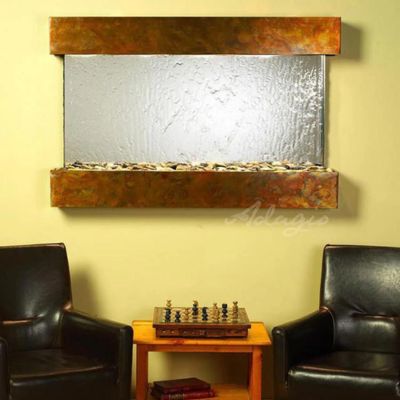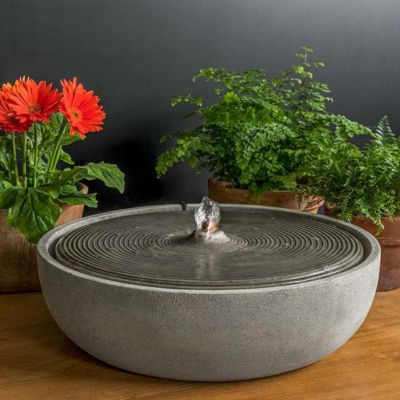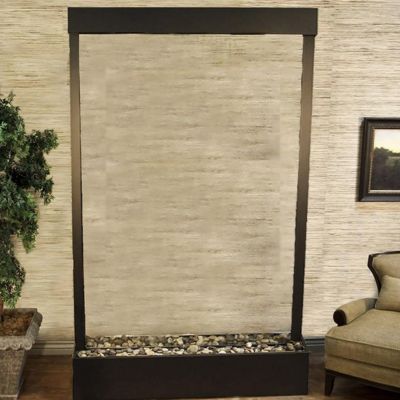What Makes A Good Waiting Room Water Fountain
Discover how to enhance your waiting area with the perfect water fountain. Find out what makes a good waiting room water fountain in our latest blog!
A good waiting room water fountain should be clean, easy to use, and quiet. It must fit the space well and have a filtration system to ensure the water tastes fresh. Proper maintenance and accessibility for all users, including those with disabilities, are also crucial.
When selecting a water fountain for a waiting room, we consider several factors to ensure it complements the space effectively. Size and design are crucial as the fountain must fit seamlessly into the waiting room without overwhelming it. Moreover, the acoustics of the water feature demand careful consideration; the sound should be sufficient enough to provide a sense of calm but not so loud as to become a distraction or interfere with privacy.
Importance of Water Fountains in Waiting Rooms

When considering refining the ambiance of a waiting room, installing a water fountain is a strategic choice. Not only does it serve as an attractive focal point, but it also brings many benefits to the area designed to welcome guests. Here, we explore the valuable role water features play in such environments.
Creating a Relaxing Environment
The gentle sound of water trickling in a fountain introduces a soothing background noise that masks the less pleasant sounds of a busy setting. This auditory feature often helps clients to relax, transforming the wait into a moment of tranquility. Research shows that natural sounds, like flowing water, significantly contribute to relaxation.
- Soothing sounds: Water features make waiting experiences less stressful.
- Ambiance of peace: A serene environment is established, aiding guests in a positive waiting experience.
Enhancing Business Image
A water fountain can leave a lasting impression on clients and customers. Such an original decoration speaks to a business’s professional image and commitment to client comfort.
- Professionalism: An elegant water feature reflects a robust professional ethos.
- Welcoming atmosphere: A water fountain can make the space more inviting and comfortable for everyone.
Promoting Mental and Physical Health
Water features support mental health by providing a calming environment that can help reduce anxiety. A relaxing waiting room can make a significant difference for clients who may be nervous or stressed.
- Stress reduction: The calmness associated with water sounds can ease mental tension.
- Improved sleep: Ambient noise from water features is sometimes linked to better sleep patterns, which improves overall health.
Improving Air Quality and Humidity
Indoor water fountains function as natural humidifiers, adding wetness to the air, which can be especially helpful in dry climates. They also emit negative ions, similar to rainfall, which can improve air quality and freshness.
- Humidity: Adds necessary moisture, especially useful in environments with dry air.
- Air quality: The negative ions can enhance air quality, potentially offering respite from airborne irritants.
By incorporating water fountains into our waiting rooms, we affirm our attention to client satisfaction and wellness while enhancing the space's aesthetic quality.
Design Considerations for Water Fountains

When selecting a water fountain for your waiting room, it's essential to consider its size, materials, alignment with your brand, and whether an indoor or outdoor model suits your space. We'll explore these factors to ensure your water fountain enhances the ambiance effectively.
Assessing the Space
Before choosing a water fountain, measure your waiting room area to determine an appropriate size. A large, open space may accommodate a floor fountain that becomes a focal point, while a smaller area might benefit from a wall fountain to save floor space without sacrificing aesthetics.
- Large Spaces: Opt for freestanding models that can serve as a centerpiece.
- Small Spaces: Consider a wall-mounted fountain to maximize space.
Selecting the Right Materials
The right materials can turn your water fountain not just into functional decor but a piece of art. We recommend materials that balance durability and visual appeal:
- Stone and Glass: Provide a natural and sophisticated look.
- Stainless Steel and Copper: For sleek, contemporary designs.
- Fiberglass: A lightweight and versatile option for various styles.
Choose based on the existing decor and desired maintenance level.
Incorporating Business Branding
Your water fountain can also reflect your business identity. Customizable elements such as your business logo or thematic inclusions can be incorporated into the design, providing a degree of personalization that reinforces brand recognition.
- Personalization: Add a logo to connect the piece to your business.
- Colors and Motifs: Choose designs that complement your business's color scheme and motif.
Let's ensure that the water fountain in your waiting room serves its purpose and does so with a perfect blend of form and function, mirroring your business's core values and aesthetic.
Types of Water Fountains

When we consider adding a water fountain to a waiting room, it's essential to understand the types available and how they can complement the space. Each style offers unique benefits and aesthetic appeal suited for different environments.
Freestanding Indoor Fountains
Our freestanding indoor fountains are a central focal point, often placed in the center of a waiting room or against a vacant wall. These can range from simplistic designs to ornate pieces featuring glass, stone, or metal. Their construction can include tiers, which add visual appeal and contribute to the calming sound of cascading water.
- Materials: Stone, Glass, Metal
- Sounds: Calming trickle to pronounced water flow
- Key Benefit: Acts as a focal point
Wall-Mounted Fountains
Wall-mounted fountains save floor space while offering an artistic touch to our walls. The water panel is a standard feature where water runs down a textured surface, providing visual motion and soothing sounds. These fountains can range from minimalist designs to elaborate installations that span the height of a wall, converting a blank wall into a dynamic water feature.
- Designs: Minimalist to Elaborate
- Space-saving: Ideal for smaller rooms
- Feature: Water panel with soothing acoustics
Tabletop Indoor Fountains
Tabletop indoor fountains bring the calming presence of water into smaller, more intimate spaces within the waiting room. They're easy to put on shelves or tables, and they come in many shapes and sizes, from simple spheres to complex arrangements with tiers or urns. These fountains are perfect when we need a touch of tranquility without dominating the room.
- Placement: On tables or shelves
- Design Options: Spheres, Tiers, Urns
- Size: Compact and discreet
Specialty Fountains
Finally, our specialty fountains cater to unique preferences or specific thematic elements within the waiting room. Examples include custom designs, interactive water features, or fountains combined with plant life. These types of fountains are often crafted to fit our space's specific aesthetic or functional needs.
- Customization: Tailored to theme or preference
- Variety: Interactive features, botanical elements
- Purpose: To fit unique space requirements
By understanding these different types of water fountains, we can better decide which will enhance our waiting room's ambiance, functionality, and overall design.
Considerations for Adding a Logo
When we plan to incorporate a logo into a waiting room water fountain, several key considerations ensure the addition is aesthetically pleasing and effectively enhances our brand.
Brand Visibility and Recognition
Integrating our logo on a water fountain can significantly boost brand visibility. The constant exposure to those waiting can cement our brand in their memory, giving us an edge in brand recognition.
- Positioning: Ensure the logo is placed where it is easily visible to those entering the room.
- Size: Opt for a size that is noticeable but manageable.
Designing an Effective Logo
Our logo design should be simple yet impactful to maximize its effect on the water feature.
- Color Scheme: Choose colors that stand out against the fountain but maintain our brand identity.
- Simplicity: A complicated logo may translate poorly onto the water surface; simplicity can be essential.
Successful Integrations
We can learn from examples where logos have been seamlessly integrated into water fountains, boosting the space's elegance.
- Material Compatibility: Select water-resistant materials for the logo that can withstand the fountain’s environment.
- Lighting: Consider backlighting or spotlights to emphasize the logo in varying light conditions.
We can add a water feature to our waiting room that is both a relaxing and welcome piece of art and a smart way to boost the visibility of our business by carefully considering these factors.
Different Materials Used in Water Fountains
When considering the addition of a water fountain to a waiting room, we have to pay special attention to the materials used in their construction. Each material brings its own set of benefits and aesthetics.
- Glass: We often select glass for its modern look and feel. The transparency of glass water fountains allows for seamless integration into any space, providing a sophisticated touch while enhancing other design elements of the room.
- Granite: As one of our top choices, granite stands out for its durability. It offers a classic aesthetic to any water fountain, and various textures and colors can match different decors, giving each piece a distinct appeal.
- Slate: For a more natural look, we turn to slate. Its rugged appearance and unique textural appeal create a focal point in the waiting room that is both calming and intriguing for those in the area.
- Marble: We recommend marble when aiming for an elegant and timeless appeal. The luxurious veining patterns in marble make every fountain appear as a bespoke piece of art.
- Mirror: In smaller waiting rooms, we prefer using mirror materials. They reflect light beautifully and enhance the illusion of space, making the area feel more open and airy.
Each of these materials can be formed and styled to fit the specific atmosphere of a waiting room, ensuring the water fountain serves both as an art piece and a source of tranquility for visitors.
Installation and Maintenance
In our experience, a well-installed and regularly maintained water fountain can transform a waiting room from drab to delightful. We will show you the most important things you need to do to set up and take care of your pond.
Setting Up Your Fountain
When we install a water feature, we start by ensuring that the location supports the weight and size of the fountain, especially if it's a large one with a substantial basin. It's critical to be near a power outlet for the water pump and to place the fountain on a level surface to avoid uneven water flow. We always recommend following the manufacturer's instructions closely to assemble the parts correctly.
Routine Maintenance
To maintain our water feature's allure and functionality, we follow a simple yet effective maintenance routine:
- Weekly Cleaning:
- Wipe down: We use a soft cloth to remove dust or debris from accessible parts.
- Check the water level: We ensure the water level is adequate so the pump can operate properly.
- Monthly Check-Up:
- Inspect the pump: We examine it to clear any blockages and ensure it runs smoothly.
- Clean the basin: We drain and clean the basin to prevent any buildup.
- Water Treatment:
- Use distilled water: To prevent mineral deposits, we fill the fountain with distilled water.
- Algae prevention: According to the manufacturer's guidelines, we occasionally add an algae prevention solution to keep the water clean.
By following these steps, we ensure that our water fountain remains a captivating centerpiece and operates efficiently for years.
Conclusion
A water fountain in a waiting area enhances the ambiance, reduces visitor stress, and improves air quality. Careful selection and placement can transform a fountain into a strategic feature that elevates the space's aesthetic and functionality. Our expert advice is to thoughtfully integrate water fountains into your waiting room design. This enhances the overall experience for clients and supports a positive, professional business image. These aspects should be carefully considered to maximize the benefits of adding a water fountain to your space.
Frequently Asked Questions
In addressing common inquiries, we aim to clarify your choices regarding water fountains for your waiting room, focusing on design, maintenance, material, sound level, health, hygiene, and size.
What are the important design factors when selecting a water fountain for a waiting room?
When choosing a water fountain for your waiting room, we consider aesthetics, space accommodation, and the demographic of the clientele. The design should be inviting and suit the overall decor while ensuring it doesn't overwhelm the available space.
How often should maintenance be performed on a waiting room water fountain?
We recommend regular maintenance, typically once every two months, to keep the fountain clean and functioning optimally. However, this may vary depending on usage and manufacturer guidelines.
Can the material of a water fountain impact the ambiance of a waiting room?
Absolutely. The fountain's material can influence the room's atmosphere; stone or slate can create a natural and serene environment, while metal can add a modern and sleek touch.
What sound level is appropriate for a water fountain in a professional setting?
The sound level should be low enough to provide a relaxing ambiance without disrupting communication. A gentle, steady trickle is typically ideal for maintaining a calm but professional environment.
What are the health and hygiene considerations for a waiting room water fountain?
We prioritize health and hygiene by ensuring the water fountain features a filtration system and is cleaned regularly to prevent bacteria growth and accumulation of debris.
How does the size of a water fountain influence the waiting room environment?
The fountain size should be proportionate to the waiting room’s dimensions. A larger fountain can be a focal point in spacious areas, while a compact design is more suitable for smaller rooms to avoid cluttering the space.


